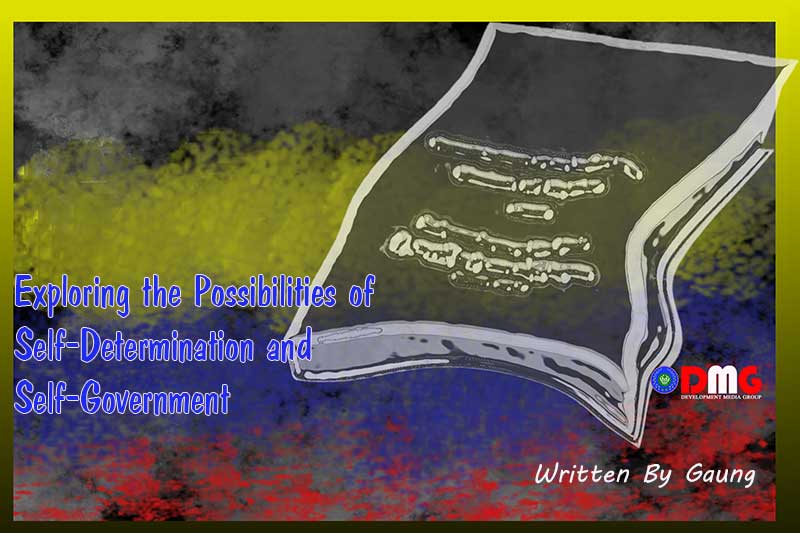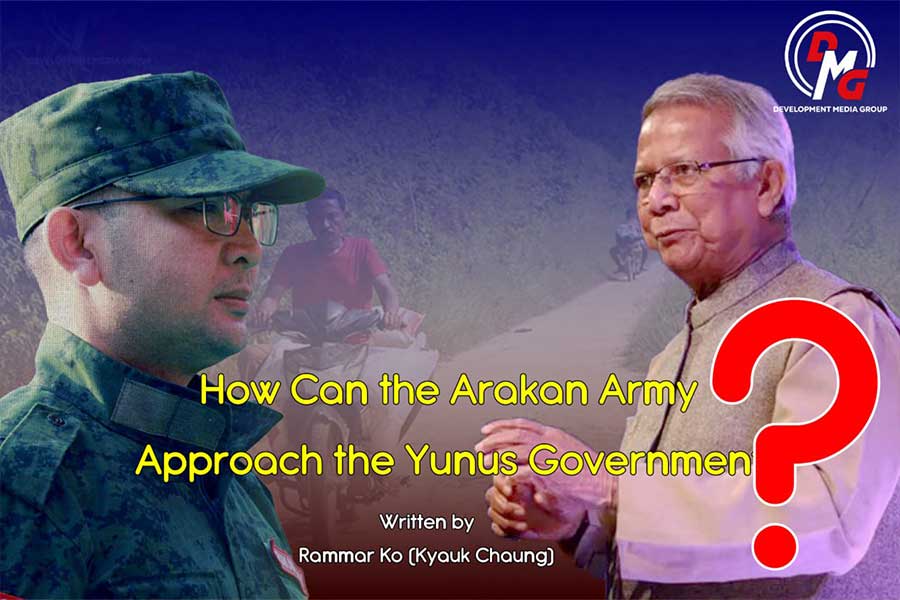- Residents in AA-held areas face new restrictions on travel outside Arakan State
- Natural fertilizer gains popularity among farmers in Arakan State
- Cut Off and in the Dark: How Communications Blackouts Are Deepening Human Suffering in Arakan
- ULA Health Department urges pharmacy owners to apply for drug sale, import licences
- Betel leaf cultivation booms in Arakan State amid rising prices
Exploring the Possibilities of Self-Determination and Self-Government
Self-administration is government and policies under the control and direction of the inhabitants of a political unit, rather than by an outside authority. Both self-determination and self-administration have long been desired by Myanmar’s ethnic minority groups.
03 Aug 2022

Written By Gaung
Conflicts in Myanmar are uniquely complex, and this complexity is a dominant undercurrent of the peace process and political issues in the country.
Amid the ongoing political crisis and civil war, the junta chief has held peace talks with the leaders of some ethnic armed organisations (EAOs). At those meetings, the junta chief promised to grant self-administration and self-determination, and in return EAOs were to agree not to secede from the country.
Let’s take a look at what constitutes self-determination and self-administration, and consider the implications of similarities and differences.
Self-Determination and Self-Administration
Self-determination is a basic principle in international law. It is defined as the free choice of one’s own actions, without external compulsion. In other words, the people of a territorial unit must be able to make decisions by themselves, for their own future political status, without compulsion from the central government.
Self-administration is government and policies under the control and direction of the inhabitants of a political unit, rather than by an outside authority. Both self-determination and self-administration have long been desired by Myanmar’s ethnic minority groups.
Self-administration exists in various forms. In Myanmar’s case, there must be a charter that guarantees territorial units self-governance and the freedom to handle the affairs of local people, without compulsion from the central government.
Secession
Secession, meanwhile, has been a taboo subject under successive military regimes, including the current one. The current regime promises a federal Union, and sticks to the Nationwide Ceasefire Agreement as the cornerstone of the country’s peace process.
In pursuing the goal of self-determination and self-government, the definition of secession in the Myanmar context, according to the ethnic people, encompasses the right to break away from this country and establish a new nation.
But the right to secede comes along with the right to incorporate. If we demand the right to secession, we must also accept the right to incorporate.
Locals in ethnic states are locked in a vicious cycle of poverty as successive military dictatorships and governments exercised centralised control in the so-called Union and used natural resources from ethnic states as they wished, without sharing the benefits with locals.
This has prompted ethnic people to try to struggle out of the Union system. Modern societies increasingly hold the belief that the rights to secession, incorporation, self-determination and self-government are the birthright of every race.
People of a territorial unit may seek to secede if they no longer wish to live under a political framework that does not fit them, or if they don’t feel themselves in harmony with other parts of the country. It must be the people who have the right to decide whether or not to secede from a country.
In Myanmar’s political landscape, secession was the goal of essentially every revolutionary organisation in the past. At the dawn of then-Burma’s independence, national leader General Aung San also guaranteed ethnic people’s right to secede.
When he and other ethnic leaders signed the Panglong Agreement in 1947 to claim independence for Burma as a Union, he promised that ethnic states could secede from the country if they were not happy with their status in the Union after 10 years. General Aung San was trusted by ethnic leaders and arguably had the ability to establish harmony with ethnic people. However, he was assassinated before independence and did not have a chance to make good on his word.
General Aung San’s promises were shattered when Ne Win seized power in a coup in 1962. The word “secession” was banned in peace talks and political discussions with ethnic armed groups. Secession is still viewed as a taboo subject, and discussion on secession has always been put off at peace talks and political dialogues.
Codifying Secession as a Right
Some countries have charters that regulate secession. For example, Article 39 of the Constitution of Ethiopia allows for self-determination, including secession, of every nationality and people.
In 1905, the union between Norway and Sweden was dissolved with the approval of the two countries. In 2014, the people of Scotland voted in a referendum concerning Scottish independence from the United Kingdom, this case being an example of a territorial unit considering its secession unilaterally. (Scotland voted to remain in the United Kingdom, by a vote of 55.3% against secession and 44.7% in favour.)
In Myanmar, there are more than 20 ethnic armed groups that have been rebelling against successive governments. Their dissatisfaction with the military and its non-disintegration dogma predates the 2021 coup.
Among the ethnic armed organisations that have been fighting against successive governments are the Arakan Liberation Party; Chin National Front; Democratic Karen Benevolent Army; Kachin Independence Organisation; Karenni National Progressive Party; Karen National Union; KNU/KNLA Peace Council; Lahu Democratic Union; Myanmar National Democratic Alliance Army; National Democratic Alliance Army (Mongla); New Mon State Party; National Socialist Council of Nagaland; Pa-O National Liberation Organisation; Restoration Council of Shan State; Shan State Progressive Party; Ta’ang National Liberation Army; Arakan Army; United Wa State Army; Arakan National Council/Arakan Army; and Shanni Nationalities Army.
Seven NCA signatories and three NCA non-signatories registered to attend the junta’s peace talks while 10 or more ethnic armed groups refused.
Each of these groups has a different history and political background. The attitudes and support of local people also vary. Some of the EAOs that remain without peace talks with the military junta are closer to reaching their goal of self-determination than others.
Words Matter
In Myanmar, the 2008 Constitution defines a handful of autonomous regions including for the Naga, Pa-O and Kokang, among others. However, these areas have been criticised for not being free from centralisation in real terms. Therefore, under the 2008 Constitution, will self-administration bring about true self-determination in the long run?
Self-government must be grounded in social cohesion, equality and the security of a given territorial unit’s citizens.
In Myanmar’s ongoing peace process and its associated political dialogue, the definitions of terms like autonomy, self-determination, secession and federalism are important, and unfortunately remain ambiguous and subject to the individual interpretation of any given stakeholder.




.jpg)















